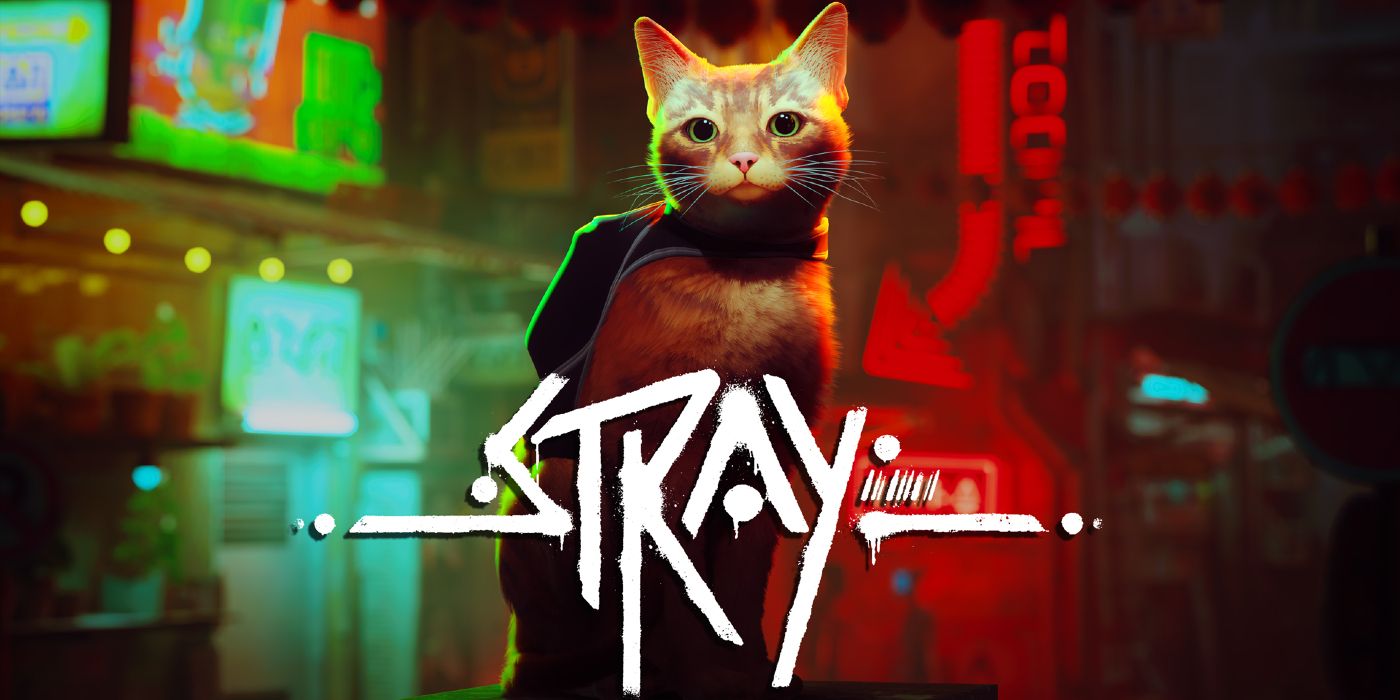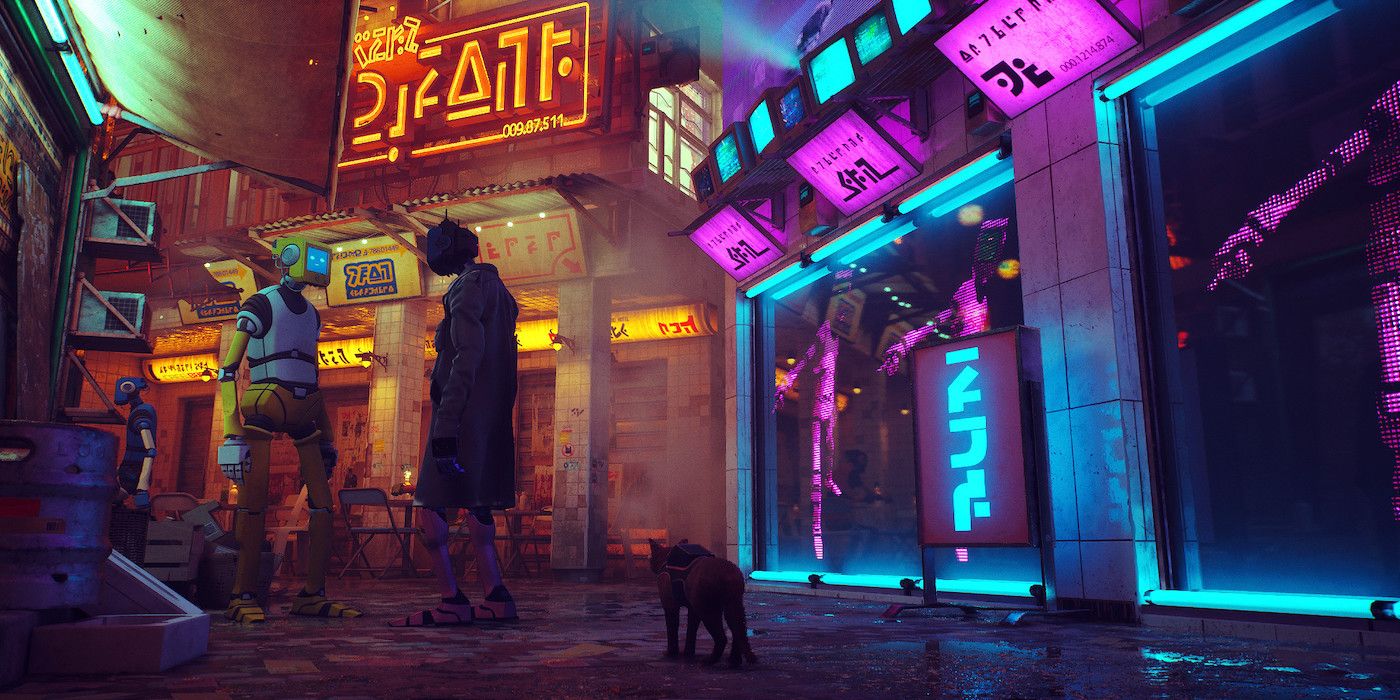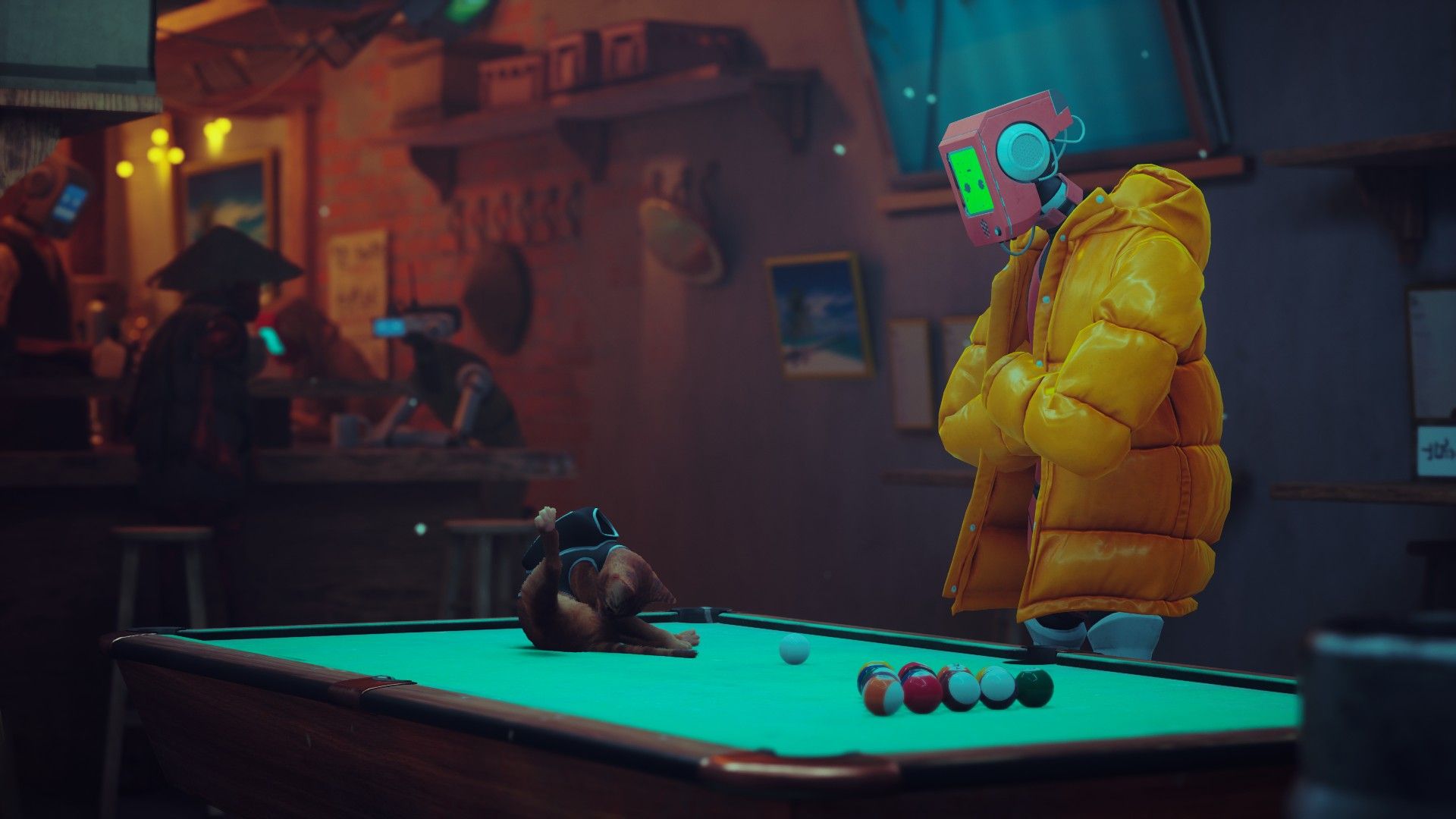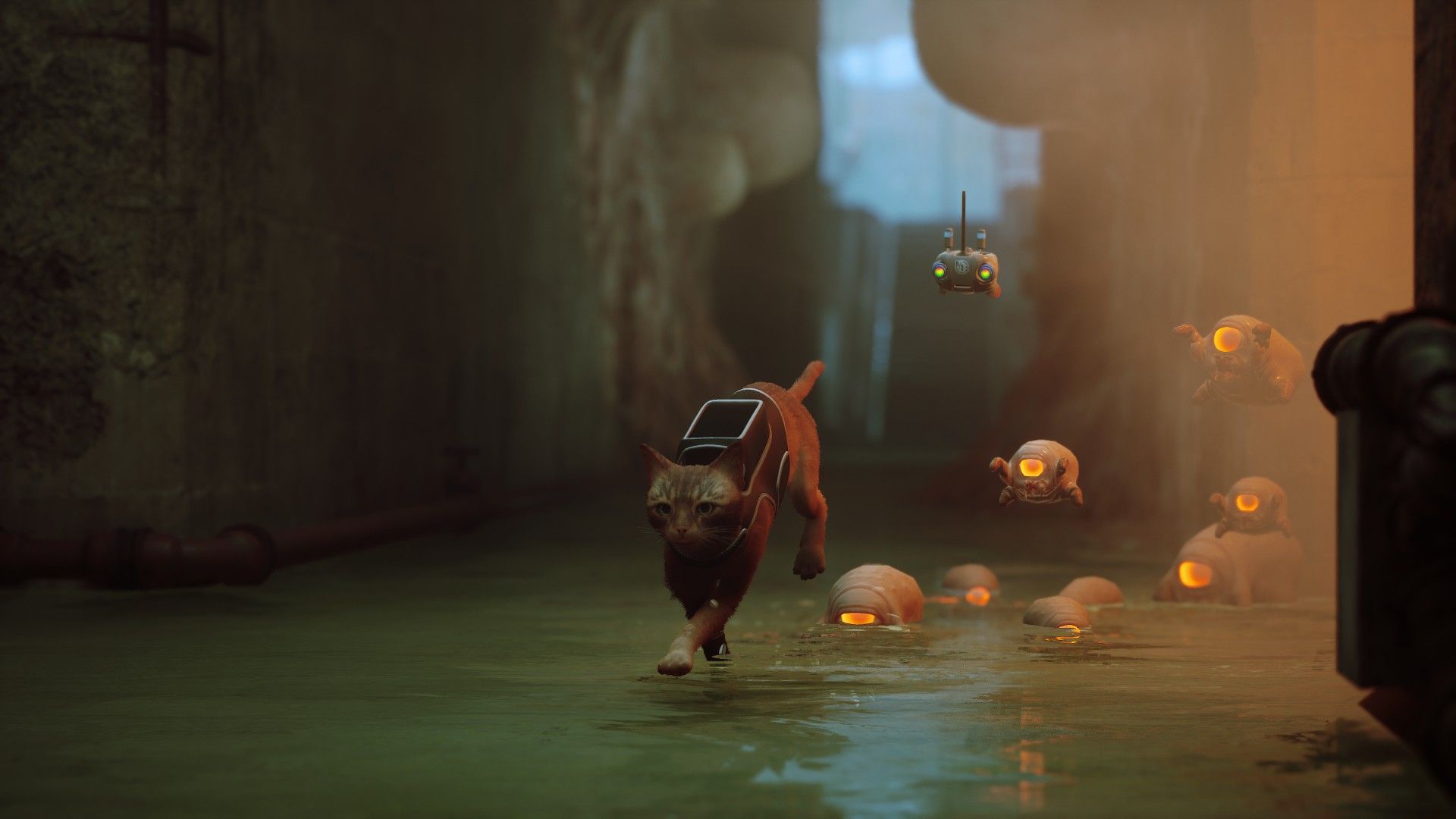Highly-anticipated Stray is a platforming adventure game starring an adorable cat protagonist. The game is developed by Blue Twelve Studios and published by Annapurna Interactive, which in the past has published critically-acclaimed titles like Twelve Minutes, Sayonara Wild Hearts, and Outer Wilds. Set to release this July, Stray offers a robust story, a large and explorable cyberpunk city, and a more realistic cat experience than most games with an animal protagonist.
Stray begins with its cat protagonist dropped in a neon-drenched city all alone, separated from their loved ones. Players will navigate the city through unique platforming that takes advantage of a cat's small size and agility as they learn about the history of the city through environmental storytelling. A host of robot characters populate the city, all with their own backstory and frequently offering quests players can participate in. Players will have to learn about the city and avoid its dangers in order to escape and reunite with their family.
Blue Twelve Studios' Producer Swann Martin-Raget took the time to talk with Screen Rant about the development process behind Stray and its gameplay, including its inspiration, design process, influence from real-life cats.
I was lucky enough to attend the Stray preview, which was really awesome. What has the evolution of Stray been like, and how much has it changed from when you first had the idea for the game?
Swann Martin-Raget: The story of the project really started with Viv and Koola, who are co-founders and directors on the project. They were artists before starting the company, and they were fascinated by this place that no longer exists called the Walled City of Kowloon. It was very peculiar place, because the density of people was really high and the construction seems to be almost organic; the amount of detail was fascinating to them. As artists, they were really inspired by this place, and the more they were thinking about it and trying to find an artistic direction, they started to realize that it would really be the perfect playground for a cat. The were so many different paths and fresh points of view that you can have in the world they were building.
That's really the moment where the project started to take precise shape in their head. They've been working on this with a lot of gameplay intention. It was clear very early on that they wanted to do an adventure game; that the story of the place was very important, and the pacing of the game, the action sequences and everything. They really had a lot of ideas, and they were really inspired by the concept.
And then we started to build the company and have a team working on it. We started doing a lot of prototypes with all the gameplay ideas. I think the general direction remained very stable for the whole project; we really knew what we wanted to do. The only thing that maybe changed is the scope of the game, the amount of features and the amount of things they wanted to do. Because from very early on, we knew that we wanted to remain a small team. That's something we really enjoy; to work with a small amount of people to have this simulation and communication going.
We reduced the scope to pick our battles and tried to choose the features and the faces and the moments that were really important for us in the project, rather than try to do everything. But in terms of general feeling and direction, looking back at all the experiences I had in my career, it was very stable throughout the process.
Something really unique about Stray is that most games that have an animal protagonist don't have a realistically portrayed animal. Usually, the cat will be walking on its back legs or have dexterous hands or something like that. But this is the pure cat experience in the best way. What made you guys want to take that very realistic approach to a cat protagonist?
Swann Martin-Raget: I think there are several sides to this question. The first and most obvious is that I think about 80% of the team are cat owners and cat lovers, and we are definitely passionate about this animal and the bond that we can have with them. That was really quite natural for us to try to make a game that is really a love letter to them, and portraying them as realistically as possible was something that really drove us along the way.
But I think it's also important to mention that we do not aim to make a super 100% cat simulator, which a cat specialist will actually agree with. There definitely are some situations, and even the drive of the story, that are made to keep the adventure interesting and believable. And we're not cat experts by any means. We're just a lot of people that have cats, and people that have adventures with them, or have things that happen to them and their cat.
We do share a lot of experience, and we know even more now that we did this project - obviously, we learned a lot about our companions. But we're not like scientists. We don't know the topic 100%, for sure.
And you have a few cats at the studio with you that you've used in the development?
Swann Martin-Raget: We do! There are two cats that work with us every day. One of them is called Oscar, who is actually a sphinx; very nice cats that are really unique. And we also have Jun, who is a black stray that one of the artists found.
But the main character was actually inspired by a red stray that is one of the two cofounders' cats, Murtaugh. He is a red stray that we found close to Montpellier about seven years ago. It's not an exact copy for sure, and the story is widening, but it's a very important reference that was used throughout the whole development.
For the movements, you also utilize the sphinx cat, right? Because you can just see, without the fur, how all of their movements work.
Swann Martin-Raget: Yes, Miko did a few videos of him jumping around to try to see the movement. We're not aiming to design some muscle precise animation, but it's definitely way easier to see on the sphinx than on a long-haired cat. Oscar's a really good actor; he takes direction precisely.
One of the big things in this game is the contrast between the fluidity of the cat and its motions and the rigidity of the robots; the cuteness of the cat with the dark loneliness of the world. What was that balancing act like?
Swann Martin-Raget: I think the idea of contrasts is in several layers of the game, and something that really drove us and that we explore. Because I think the initial setting of just having cats with robots in a futuristic setting with all the retro technology was already there since the beginning, so it was more us trying to explore these themes. We were keeping in mind that we wanted this contrast be as interesting and surprising as possible.
Every time we added a new situation, or a new type of interaction with the cat and the robots, or build a new level and think about the story behind it and what happened - it was always driving us that we were more exploring the initial idea rather than trying to add that contrast.
You said in the preview presentation that this game really rewards exploration, because there have been so many small details included in the game that tell the backstory of the city and its inhabitants. What was the process of storytelling through the environment?
Swann Martin-Raget: I think we really kept the inspiration open throughout a long time. When we were trying a new environment or were trying a new type of gameplay sequence, and we started prototyping, it always added to the story in the background and the world that we were building in our heads. It was really evolving quite a lot throughout the whole project.
There are several layers of story. The cat's point of view is really simple, and it has this objective. But there's also B12, who is a character on his own and has his own story as well. The city itself and the inhabitants are part of this story as well, and they will make a puzzle that you complete as you progress.
Some things are very clearly explained in the story when you're talking the main characters, but hopefully the most curious and exploratory players will find some real hints and details that we that level artists love to add in everything they do. That makes it interesting to just walk around.
That mirrors the nature of a cat, in that they want to explore every corner and every inch that they can.
Swann Martin-Raget: That's why we tried to have players feel this almost extending territory feeling, which I think cats are trying to have.
You made a new robot alphabet for the game. What was that process like?
Swann Martin-Raget: I think the intention behind that was initially to really try to make players feel that they landed in a place that they don't understand. They don't have the codes and the rules, and it's really alien for them. They are lost, and having the readings and everything that you see around you be in language that you cannot understand is a very important part of that.
We worked on the design of it, to try to have it consistent with everything. Without any spoilers, that opened doors about the backstory of the city and robots, and how they developed basically. It's another example of something that we did for one initial intention, but which we explored as we were making the game.
The feeling of alienation and loneliness is not a bad thing in this game's context, because this cat is just dropped alone into an unfamiliar city. That really does add a different layer of confusion, and it's very cool.
Swann Martin-Raget: The feeling of danger as well was important; feeling that you're not welcomed here, you're not supposed to be here, and that you have to understand where you are and how it works.
It's interesting the way you've balanced these more adorable characters - like the grandma droid talking about knitting - with these pretty intense chase sequences. It seems like it's always been really important that the story is the main focus, and the action is more something that switches things up.
Swann Martin-Raget: Yes, I think the really important idea behind it is rhythm and pacing. That's really how we utilize the more fast-paced action sequences; to give variety and surprise to the progression to the story of this adventure and this journey. Having pieces of the game where you really are under a bit of stress, pieces of the game where you're more fascinated with a new place to explore, and pieces of the game where you have to think and take your time to understand something very specific really helps to build this rhythm and keep the story and the progression interesting.
That's really how we used all these elements to have something that feels consistent. Hopefully a lot of players will go through the entire game and have the full experience thanks to this.
You made a choice that I really love, which is where every jump you make will succeed. I think it'll help the player focus on where they're going and how they're doing it versus, "I need to time this jump, so I can make it across here."
Swann Martin-Raget: Yeah, that was a really important moment in the project. And it's really something that we did talk a lot about. Basically, when you see people playing it - except the very experienced and super familiar players - they keep missing the jumps. They keep having close calls and keep having this wonky feeling that you're not really fluent in this space. The advantage of being a cat for us is really as far as it can be from this.
Obviously, cats sometimes miss their jumps sometimes, and it's really funny - on YouTube and things. But they're such agile and smooth creatures, and seeing them just walk around is so fascinating because of this. That was really incompatible, but it was really important for us to keep the freedom and the exploration aspects. So, you really do have the freedom to go everywhere you want. It's just going to be very smooth, very easy, and very fluid.
Shifting the challenge from judging distances to just looking and jumping around very easily is something that really fits with the fantasy.
It's something that's very unique to the cat protagonist as well, because of their size. The way these levels are designed is completely different than it would be for a human protagonist, because you can work with all these different levels that a cat can traverse.
Swann Martin-Raget: Indeed, and that makes a lot of classic production steps on other games very unique for our projects. For instance, in terms of level art: in any other game, you add an aircon unit or a pipe going around the building. If it looks pretty, then you're good to go, and it's fine. But in our case, it's a new path and a new place that players will want to go to. It's a new point of view on the whole scene that you need to work and feedback and make consistent with everything.
It was a lot of back and forth between level designs, and also a huge amount of play tests. We spent hours with new players telling us where they feel they should be allowed to go, where they want to go, and if they understand the feedback clearly. It was very specific for that project.
I love that you let the player do the annoying things that cats do. They can knock things off a ledge, or they have the adaptive trigger scratching on the wall. It gives the player these moments of rest, where they can just be a cat and do silly cat things.
Swann Martin-Raget: Yes, that was so important. Having cats in the studio working with us, we were constantly reminded how much we love them. [Laughs] But when they step on the power button as you're about to save your work, or when they start singing just before a very important call with the publisher - it was really this constant reminder that if we want to have a realistic sort of simulation, it definitely needs to have this more lovingly annoying side.
And you've given them tons of things to play with in the environment too. It's very clearly a game that was designed by cat lovers.
Swann Martin-Raget: Yeah. We are a small team, so we need to choose our battle. But we really tried hard to add as many cat interactions as possible that we are familiar with, that we know and see almost every day on the internet as well. It's a bit of a constant source of inspiration; we can come up with a new idea quite easily. Adding this as much as possible in the game was a pillar for us, definitely.
It's focused on its story, with the beats and stuff that you've described, but it still gives a little wiggle room for players. It's not strictly linear. I know there's side quests, but about how much of the game would you say contains side quests that you can embark on?
Swann Martin-Raget: Again, because we're a small team, I think it's good to not expect an incredible amount of content. We tried to add some things that were interesting to us and relevant to the fantasy. A lot of cats interactions are purely cosmetic, so they're purely there for the roleplay side of the game; to make you feel like you are a cat that is physically in this world.
In terms of actual gameplay side quests that are rewarded and part of the game, there are quite a few. But if you just want to try to feel like you really are a cat in this world, I think there's a lot of things to see and try to get.
Ever since I was a kid, I was like, "Man, if I was a cat, it would be a lot cooler." Although this cat does have a lot on its plate, in terms of things that needs to be accomplished.
Swann Martin-Raget: It is definitely a busy day. We always say that if you really wanted to have a realistic simulation, it will be about sleeping 21 a day. It wouldn't make a very interesting game, probably.
Although you can nap in Stray.
Swann Martin-Raget: Yes. And there might be some trophies related to this, but maybe I shouldn't say that.
I'm so curious to see where the overall story arc is going to go. As a cat lover, I assume that you haven't put anything to heartbreaking in this game. I don't know if you can reveal that.
Swann Martin-Raget: Obviously, learning about the place and discovering the story and its inhabitants in the characters is definitely one of the most interesting things to do in Stray. We try to keep the amount of information that we tell about this minimal.
But no cats were injured making Stray, I can promise you that. The well being of our animals is an absolute top priority. But this cat goes on an adventure, for sure, so a lot of things are going to happen.
Even just the chase scenes, I'm always so stressed. But it looks like even if you fail that, you're not seeing the cat get hurt or anything like that.
Swann Martin-Raget: To be precise, the cat can actually die during two sequences. It's a very short checkpoint, so you spawn back very close to where this happens. But in some sequences, the cat is actually in danger, and we wanted to portray that in a way that will hopefully raise the empathy that you have with your character. Maybe that will trigger some empathy in the real world, where people will want to avoid that happening to real cats in the world.
Do you think there's a possibility that the release of this game will encourage people to get a cat if they don't already have one?
Swann Martin-Raget: I really don't know, but I hope so. There are so many stray cats that need homes and love. I don't know if our game is going to make that happen, but that will be a very good thing for the whole team. Even if it's just for cosplay purposes initially, if people adopt cats, that would be awesome.
I think it's going to be a really exciting game for cat lovers especially. But it also gives a very realistic cat perspective that might help soften people a little bit, being empathetic with that main character.
Swann Martin-Raget: Yeah, hopefully. We really are curious to see the feedback from actual cat owners, because that's really what we had in mind making the game. But it will be interesting to see if the other teams are interested in the game as well.
I'm very excited to have my two cats watch me play and see if they react. Because they do often try to attack the screen when I'm playing.
Swann Martin-Raget: Yeah, we had that during the development, where the cats in the studio started to react to what was on our screen. It was a very good moment, because we felt that we were on the right path.
Especially the sounds. If you use the meow button, it should trigger a reaction.
When I learned that this game has a dedicated meow button, I lost my mind. Before we go, is there anything that you want readers to know about Stray?
Swann Martin-Raget: No, I think everything we've discussed is really important. The fact that we are a small team is something that we really wanted to convey, because players expect 100 hours of open world.
We really tried our best, and it's our first game as a studio with this team. We put our heart in it, for sure, and we really hope that people will enjoy it.
Stray will release on July 19th for Playstation consoles and PC, and become available to PS Plus Extra subscribers on day one.




